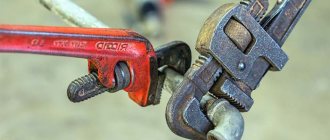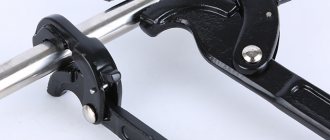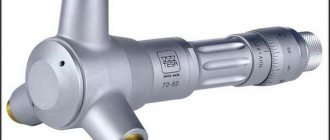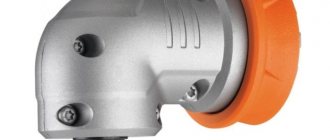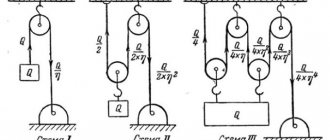Hands from the right place | 04/12/2016
Every self-respecting master in his collection of tools, in addition to several dozen ordinary wrenches, has an adjustable wrench. There are situations when you don’t have a suitable size wrench at hand or you need to unscrew a non-standard connection; it is at this moment that our universal adjustable wrench comes to our aid. Today, we will find out what sizes and numbers of adjustable wrenches there are, touch on the history of creation and talk a little about the right choice.
What is an adjustable wrench
An adjustable wrench is an adjustable tool with movable and fixed jaws.
It is adjustable thanks to a rotating mechanism that allows it to be used with nuts, bolts, etc. of different sizes, so they are more versatile than fixed wrenches.
Adjustable with horn profile
Direct descendant of the classic key. From his ancestor he inherited some of his advantages and all his shortcomings (adding to these shortcomings his own). It has one fixed jaw, which is a continuation of the key body, and a second, movable jaw. To move the movable jaw, a worm-and-screw mechanism built into the body of the key is used. When moving the jaws, their mutual parallelism is maintained.
| Key size | Maximum fastener size, mm | |
| Inch | mm | |
| 4 | 102 | 13-14 |
| 6 | 155 | 20 |
| 8 | 205 | 27 |
| 10 | 255 | 30 |
| 12 | 305 | 35 |
| 15 | 380 | 45 |
| 18 | 455 | 55 |
| 24 | 610 | 67 |
These keys are classified by their length, which is traditionally expressed in inches (in metric countries, the inch size of a key is usually referred to as its number). The size range of keys is presented in the table. The size of the wrench determines the maximum opening of its jaws and, accordingly, the maximum size of fasteners with which this wrench is capable of working.
Like a regular open-end fastener, an adjustable fastener applies working force only to two edges of the fastener. At high torques, there is a danger of “rounding” the working profile of the fastener. Due to the inherent play of an adjustable wrench, this danger is greater than when working with a fixed-size wrench. To avoid this outcome as much as possible, when working, you should position it on the fastener so that the movable jaw “looks” in the direction of rotation of the fastener. This “selects” the backlash of the jaws, ensures reliable grip of the fastener and reduces the likelihood of “rounding” the edge of the fastener and tearing the key off it.
Any open-end wrench, including this one, can be used to work not only with hexagons, but also with four- and octahedrons, as well as with cylindrical parts on which two parallel flats are made. Some manufacturers offer wrenches with an adjustable movable jaw, which has a notch on the reverse side. This notch allows you to turn the sponge over and use the wrench as a pipe wrench.
Benefits of having a universal tool
With an adjustable wrench, you can take advantage of the tool's capabilities to tighten or loosen different types of fasteners.
- It is very useful as it can be adjusted to fit any nut or bolt so you don't always have to worry about choosing the right size of wrenches for different fasteners.
- One adjustable wrench can replace all different size wrenches, saving space in your tool cart, weight less and saving money.
- Some are better suited for the intensive use associated with general vehicle assembly, repair and maintenance, while others are better suited for household and everyday tasks.
Small keys are ideal for DIYers. They're also good for hard-to-reach corners where large keys won't fit.
So before making a decision, it is good to know its characteristics and become more familiar with this topic.
Appendix A (mandatory)
Protective and decorative coatings
Table A.1
| Group of operating conditions according to GOST 9.303 | Name of coating | Designation according to GOST 9.306 ( GOST 9.032 ) |
| 1 | Chemical oxide, oil impregnated | Chem. Oks. prm |
| Chemical phosphate, oil impregnated | Chem. Phos. prm | |
| Chrome 9 microns thick | X9 | |
| 2 — 4 | Chrome 1 micron thick with a nickel sublayer 12 microns thick | H12.X |
| Zinc 15 microns thick chromated | Ts15.hr | |
| Chemical phosphate, followed by painting the handles with nitroglyphthalic enamel NTs-132 (or pentaphthalic enamel PF-115) of different colors according to coating class IV and applying polyacrylate varnish AK-113 to the lightened surfaces of the head | Chem. Phos. (Enamel NTs-132 different colors GOST 6631 . Varnish AK-113 GOST 9825 . IV) | |
| 5 — 8 | Chrome 1 micron thick with an underlayer of electrolytically deposited nickel 14 microns thick and nickel deposited by the same method 7 microns thick | N14.N7.X |
| Cadmium 21 microns thick chromated | Kd21.hr | |
| Notes 1 It is allowed, by agreement with the consumer, to use other metallic and non-metallic coatings in accordance with | ||
Have multiple tools in one
With this tool, you can perform different tasks as if you had multiple tools in one. This way, you will not only save money, but you will also save space in your toolbox.
You never know when problems might arise with your pipes, car, or some furniture in your home, so it pays to have an adjustable wrench. It is a very versatile tool with various functions. In addition, some of them include additional functionality.
Criterias of choice
| Manufacturers | Sibrtech, Gross, Harden, Kraftool, STANLEY |
| What types of adjustable wrenches are there? | adjustable, gas lever, single-grip, straight pipe, universal, for sinks, hinged. |
| Additional functions | dielectric, ratchet, replaceable jaws |
| What material is it made from? | Tool steel, carbon steel, chrome vanadium steel, aluminum. |
| Coating | Anodized, nickel plated, powder coated, etc. |
| Maximum working width, mm | from 15 to 250 mm |
| Jaw angle | 45° , 90 ° |
| Sponge shape | B,L,S |
How to choose an adjustable wrench
As with other products on the market, you will find very different models, which can make the decision a little more difficult. When purchasing, be sure to pay attention to the following characteristics:
Adjustable wrench material
Wrenches, for the most part, are usually made from a steel alloy that will be plated with either chrome metal or some other type of material. Some finishes, such as black phosphate or metallic chrome, are better than others in terms of durability.
It is very important to keep an eye on the finish and polish of your faucet as this will help determine its lifespan. This is especially useful when repairing and servicing cars or motorcycles.
The treated coating makes the key a poor conductor of heat and therefore much safer than traditional keys. So, it is necessary to consider the material depending on the work being performed.
Adjustable wrench size
The first thing to evaluate is whether the adjustable wrench is the right size for the nuts and bolts you need it for.
Since the jaws are adjustable, in most cases you will have no problem adjusting a wide range of mounts.
For general tasks, you can select key sets.
- Today, many brands offer tools of different sizes, features and uses, so you can always choose the model that best suits your job.
- However, you won't need an adjustable wrench for every size, but for a range of sizes.
Adjustable wrench weight
Of course, the weight will be affected by the size and material from which the key is made. Always check whether the model provides ease of handling, as well as comfort and safety. Well, a handle that is too heavy can hinder the job rather than make it easier, and we don't want that to happen.
Lever pipe wrenches
Lever pipe wrenches (gas wrenches) of the entire range of sizes, from number No. 0; No. 1; No. 2; No. 3; No. 4; No. 5; No. 6; No. 7 to No. 8 have the same design, with the exception of the design of the jaws - straight and inclined or “S”-shaped. Two handles (levers) are connected via a lever mechanism. Hence the name of the keys – lever. The lower handle has a trapezoidal thread that allows the adjusting nut to slide one of the two jaws along the guides when adjusting the pipe size. The upper power handle is rigid and usually has a double “T” shaped profile. For normal work, flat hardened straight or inclined jaws are used. To work with “dead” connections, a pipe wrench of the s-shaped lever type is better suited. It can grip the pipe not at two points like a standard gas pipe wrench, but at three, which allows you to create much greater torque with the same lever. The angle of the pipe wrench jaws - 90° or 45 degrees - allows for better access to the pipe in the most difficult situations situations. For ease of searching, the designation of models of foreign manufacturers contains a key size number, which is close to the sizes of keys of domestic manufacturers according to the classification for pipe lever (gas) wrenches GOST 18981-73. Why are pipe (gas) wrenches adjustable?A natural question. Everyone is familiar with universal adjustable wrenches manufactured in accordance with GOST 7275-75. The jaw of the adjustable wrench can be adjusted using an adjusting nut to the desired size of hexagon or square. With our pipe wrenches, adjustment to the desired pipe size is done exactly like with adjustable wrenches. The adjustment mechanism is the same, only the designs differ. By the way, GOST 7275-75 did not introduce the concept of an adjustable gas or pipe wrench. The concept of adjustable gas wrenches is used in everyday life and it is so ingrained that we do not think at all when we say the word adjustable wrenches in relation to pipe wrenches. | The section of the catalog for pipe lever wrenches (gas) contains photos and pictures of gas wrenches and large photographic material from almost all major manufacturers. Photo of a Ridgid gas |
| Photo gas key Rothenberger (Rothenberger) |
The review of pipe lever wrenches (gas wrenches) includes models with basic technical characteristics and photographs of the world's leading manufacturers. The information is presented in a summary table of gas keys of the following brands: Ridgid, Rothenberger (Rothenberger), etc.
Model/brand Name of wrench Pipe diameter, inch Weight, kg
| Ridgid 1140 | Gas pipe wrench No. 0 | 3/4 | 0,4 |
| Ridgid 1141 | Gas pipe wrench No. 1 | 1 | 0,7 |
| Ridgid 1142 | Gas pipe wrench No. 2 | 1 1/2 | 1,3 |
| Ridgid 1143 | Gas pipe wrench No. 3 | 2 1/2 | 2,9 |
| Ridgid 1144 | Gas pipe wrench No. 4 | 3 1/2 | 5,3 |
| Ridgid 45° 1″ | Gas pipe wrench No. 1, jaw angle 45° | 1 | 0,9 |
| Ridgid 45° 1 1/2″ | Gas pipe wrench No. 2, jaw angle 45° | 1 1/2 | 1,4 |
| Ridgid 45° 1/2″ | Gas pipe wrench No. 0, jaw angle 45° | 1/2 | 0,4 |
| Ridgid 45° 2″ | Gas pipe wrench No. 3, jaw angle 45° | 2 | 2,7 |
| Ridgid 45° 3″ | Gas pipe wrench No. 4, jaw angle 45° | 3 | 3,5 |
| Ridgid 90° 1″ | Lever pipe wrench No. 1, jaw angle 90° | 1 | 0,4 |
| Ridgid 90° 1 1/2″ | Lever pipe wrench No. 2, jaw angle 90° | 1 1/2 | 0,9 |
| Ridgid 90° 2″ | Lever pipe wrench No. 3, jaw angle 90° | 2 | 1,4 |
| Ridgid 90° 3″ | Lever pipe wrench No. 4, jaw angle 90° | 3 | 2,7 |
| Ridgid 90° 4″ | Lever pipe wrench No. 5, jaw angle 90° | 4 | 3,5 |
| Ridgid S 1″ | Lever pipe wrench No. 1 type “S” | 1 | 0,9 |
| Ridgid S 1 1/2″ | Lever angle pipe wrench No. 2 type “S” | 1 1/2 | 1,4 |
| Ridgid S 1/2″ | Lever pipe wrench No. 0 type “S” | 1/2 | 0,4 |
| Ridgid S 2″ | Lever angle pipe wrench No. 3 type “S” | 2 | 2,6 |
| Ridgid S 3″ | Lever angle pipe wrench No. 4 type “S” | 3 | 4,2 |
| Rothenberger 45 (series) | Gas pipe wrench No. 1; No. 2; No. 3; No. 4 jaw angle 45° | 1/2-3 | 0,4 – 3,4 |
| Rothenberger 45 SUPER S (series) | Pipe lever wrench type “S” No. 0; No. 1; No. 2; No. 3; No. 4 jaw angle 45° | 1/2-3 | 0,4 – 3,4 |
| Rothenberger 90 (series). | Gas pipe wrench No. 1; No. 2; No. 3; No. 4; No. 5 jaw angle 90° | 1 -4 | 0,74 – 5,6 |
The largest manufacturers of gas pipe wrenches from the USA and Europe are presented in this section of the catalog - Ridgid, Rothenberger (Rothenberger). Most foreign companies have their representative offices or companies representing their interests in Russia. For each manufacturer, the address, company name, phone number, website, main specialization and manufactured tools are indicated. List of gas wrench manufacturers included in this section: Ridge Tool Company, USA Rothenberger Werkzeuge AG, Germany Sale of pipe lever wrenchesThe sale of pipe lever wrenches, including spare parts, is carried out by manufacturing plants and official dealers in Russia. Sales are carried out from equipped warehouses. You can select and buy the required key in our catalog. | All videos of models of pipe lever wrenches are available on the video channel Communal Machines - kommashPRO.ru. |
Lever pipe wrenches (gas) – purpose
A pipe wrench is a lever or gas wrench, used for gripping and rotating pipes with both hands during installation work on pipeline gas and water supply systems in populated areas, apartment buildings, and industrial enterprises.
A gas wrench is the main tool for working with pipes for all professional plumbers; it is also used in the household as an auxiliary tool for all occasions for fixing not only pipes, but also objects of any shape.
A pipe wrench can successfully replace a pipe vice when cutting pipe threads at home or during installation work at a construction site.
The “dead” grip allows the gas wrench to disassemble even very “boiled” connections - pipe / coupling or coupling / bend.
The most popular gas keys are from foreign manufacturers of such brands as Ridgid, Rothenberger (Rothenberger), etc.
Why is a gas key called a gas key?
Really interesting question. Almost every plumber is sincerely convinced that he works with a gas wrench, and not with a pipe lever wrench - that is what it is called according to GOST 18981-73. The explanatory dictionary leads us to the Swedish trace of this instrument.
There we will find a Swedish/Swedish adjustable key or a colloquial Swedish key. The wrench design came to Russia at the end of the 18th century and, according to our assumptions, the Swedish adjustable wrench began to be used in the development of the first oil and gas fields in the south of the country.
The keys were used to form drill rods and, most likely, it was from then on that they began to call it a gas key.
Later, when scientists took up this issue, the gas wrench officially began to be called “Lever Pipe Wrench” and, accordingly, GOST 18981-73, which is in force to this day, is dedicated to it. Now if you are asked what is the difference between a gas wrench and a lever pipe wrench, you can safely answer - they are the same pipe wrench. In our catalog we will use the term about.
Gas key - numbers and sizes
GOST 18981-73, already familiar to us, introduced the concept of key number, which determines its size - the length and diameters of the pipes being grabbed. There are five key numbers, of which the most used are No. 1; No. 2; and No. 3 sizes. It should be noted that pipe wrenches and other sizes are produced according to technical specifications - No. 0; No. 6; No. 7; No. 8.
The pipe lever wrench (gas wrench) size No. 1 has a length of 0.3 m and works with pipes in the range of 10-36 mm. The older pipe lever wrench (gas wrench) size 2 is 0.1 m longer than its counterpart and can handle pipes from 20 to 50 mm.
The most commonly used pipe lever wrench (gas wrench) is size 3, 500 mm long. will freely grip pipes with diameters from the range of 20-63 mm.
The remaining lever (gas) pipe wrenches of sizes No. 4 and No. 5 have a length of 630 / 700 mm and diameters of clamped pipes 25-90 / 35-120, respectively.
Lever pipe wrenches (gas wrenches) – model specifications
The catalog of pipe lever wrenches (gas wrenches) contains a list of models from foreign manufacturers. Detailed technical specifications are published for each model, the country and manufacturer are indicated, and a photograph of the product.
Source: https://www.kommashpro.ru/kliuchi-trubnye-rychazhnye
Opening
When it comes to wrenches, there are a wide variety. Some of them are not only mobile, but also reversible, meaning they can be completely rotated for a larger closure.
- Other models have engraved markings that help determine the size of fastener needed for a particular opening.
- Other features that may include splines attached using tension springs.
- These characteristics apply to the different types of tasks for which a wrench is best suited.
Keys with variable working profile size
Wrenches with a variable working profile size can be roughly divided into two groups: wrenches adapted only for working with a pronounced working profile (in the vast majority of cases hexagonal), and wrenches capable of working with objects of arbitrary shape.
The former will be called here “universal wrenches”, the latter, in accordance with their main purpose, “pipe wrenches”. Along with them, an internal pipe wrench is also described.
The benefits of wrenches that can handle a variety of fastener sizes are self-explanatory. Unfortunately, such keys also have significant drawbacks, which greatly limits their use. These shortcomings will be discussed below. At least two models of such keys were developed at the end of the 19th century by the Swedish engineer Johansen. These are the open-end adjustable wrench and the pipe wrench, called the "steel arm" in the original patent. The first of them is still often called “Swedish”, and the second “Bako” - after the name of the company founded by Johansen.
Restraint
The length of the handle determines the gripping ability. Therefore, longer handles are suitable for people with larger hands.
On the other hand, the width of the handle, and especially the thickness, helps determine whether you can achieve the desired leverage when using it.
This feature is especially important when it comes to making adjustments using a very strong nut or bolt. The coating on the handle is also critical as it affects the strength, glide and grip of the handle.
Control and test methods
5.1 The sizes of keys should be checked using special and universal measuring instruments.
5.2 Control of the appearance of protective and decorative coatings is carried out visually.
5.3 Hardness control - according to GOST 9013.
5.4 The surface roughness of keys should be checked by comparison with roughness samples in accordance with GOST 9378 or with control samples having surface roughness parameters not exceeding those specified in 3.2.3.
5.5 The performance of the keys is checked using test torques on a test bench. The keys are installed with an open jaw on a mandrel having the cross-section shape of a regular hexagon. The nominal dimensions of hexagonal mandrels should be taken equal to the minimum male turnkey dimensions of normal accuracy according to GOST 6424. They must correspond to those specified in 3.2.9.
The hardness of the mandrels must be at least 55 HRC.
The load should be applied to the end of the handle at a distance of no more than 50 mm from its end perpendicular to the longitudinal axis of the key.
During the test, the wrench is loaded once in each direction, gradually applying the load until the minimum torque value specified in Table 2 is reached.
After testing, the keys should not have any residual deformation affecting performance and should be suitable for further work.
5.6 Reliability tests of keys must be carried out on test fixtures or stands under the test conditions specified in 5.5. In this case, the test results are considered satisfactory if each of the controlled keys does not reach the limiting state.
5.7 The quality of galvanic coatings is checked according to GOST 9.302.
Various models of wrenches
Graduated model. These wrenches have millimeter graduations under the clamps to ensure precise pre-setting.
- This is a very common model as this scale helps us know the size of the nuts or bolts to make our work easier.
- It also usually has a hardened pliers with wheels and rollers that allow for precise graduations.
Side knurled model
This model differs from others in one detail, since the operating principle remains the same. Side-thumb wheel keys feature a stand on one side of the movable jaw.
In order to open the jaw, the central gear was replaced with a wheel on one side. This thus facilitates more accurate calibration of the instrument.
Crocodile model
Finally, crocodile models are the most versatile type because they combine two tools in one, which means even more space savings.
The difference this wrench presents is that there is another V-shaped tool at the end of the handle. It can be used to adjust other types of screws and nuts.
Normative references
This standard uses normative references to the following standards:
GOST 9.032-74 Unified system of protection against corrosion and aging. Paint and varnish coatings. Groups, technical requirements and designations
GOST 9.301-86 Unified system of protection against corrosion and aging. Metallic and non-metallic inorganic coatings. General requirements
GOST 9.302-88 (ISO 1463-82, ISO 2064-80, ISO 2106-82, ISO 2128-76, ISO 2177-85, ISO 2178-82, ISO 2360-82, ISO 2361-82, ISO 2819-80, ISO 3497-76, ISO 3543-81, ISO 3613-80, ISO 3882-86, ISO 3892-80, ISO 4516-80, ISO 4518-80, ISO 4522-1-85, ISO 4522-2-85, ISO 4524-1—85, ISO 4524-3—85, ISO 4524-5—85, ISO 8401—86) Unified system of protection against corrosion and aging. Metallic and non-metallic inorganic coatings. Control methods
GOST 9.303-84 Unified system of protection against corrosion and aging. Metallic and non-metallic inorganic coatings. General requirements for selection
GOST 9.306-85 Unified system of protection against corrosion and aging. Metallic and non-metallic inorganic coatings. Designations
GOST 2789-73 Surface roughness. Parameters and characteristics of GOST 4543-71 Rolled alloy structural steel. Technical specifications GOST 6424-73 Zev (hole), end of the key and turnkey size
GOST 6631-74 Enamels of grade NTs-132. Specifications
GOST 9013-59 (ISO 6508-86) Metals. Rockwell hardness measurement method GOST 9378-93 (ISO 2632-1-85, ISO 2632-2-85) Surface roughness samples (comparison). General technical conditions
GOST 9825-73 Paint and varnish materials. Terms, definitions and designations GOST 18088-83 Metal-cutting, diamond, wood-cutting, plumbing and auxiliary tools. Packaging, labeling, transportation and storage GOST 26810-86 Plumbing and assembly tools. Acceptance rules
Note - When using this standard, it is advisable to check the validity of the reference standards in the public information system - on the official website of the Federal Agency for Technical Regulation and Metrology on the Internet or using the annually published information index “National Standards”, which was published as of January 1 of the current year , And
Official publication
according to the corresponding monthly information indexes published in the current year. If the reference standard is replaced (changed), then when using this standard you should be guided by the replacing (changed) standard. If the reference standard is canceled without replacement, then the provision in which a reference is made to it is applied in the part that does not affect this reference.

